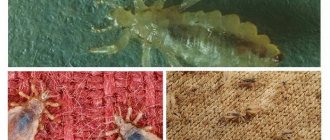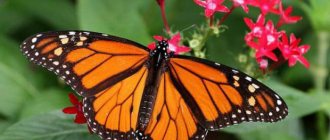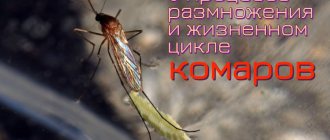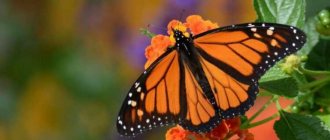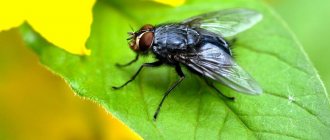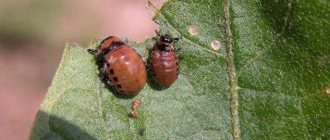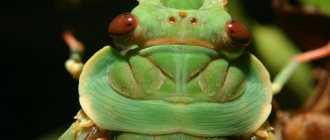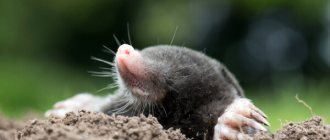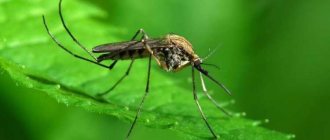It is difficult to find a person who does not know what mosquitoes are and what they do, especially after dark. But not everyone knows what types of mosquitoes exist and which ones should be wary of.
They do not give a person peace, trying to bite him in order to drink blood. In nature, there are many varieties of these blood-sucking insects, which are not useful, but have many problems.
Generally, mosquitoes prefer a moist environment in which to breed. This article explains what types of mosquitoes there are and the characteristics of their life.
Types of mosquitoes
There are more than three thousand species of mosquitoes. In the article we will consider the most common varieties that people most often encounter. Not all of the known and widespread mosquitoes in our area drink blood. Let's find out which mosquitoes can cause harm to humans, and which are completely harmless.
Common mosquito (squeaker)
An adult squeak mosquito reaches 7 mm, the legs are long, the wings are narrow and transparent, the body color is gray. They belong to the species Culex. Females are superior to males in body size and antennae length. In males, the proboscis is not so developed as to pierce the skin of a mammal, so the basis of their diet is plant foods. Only females bite and drink lymph. The life cycle of a mosquito does not exceed 48 days. The habitat and reproduction are places with high levels of humidity. This species is especially common in the central zone of our country.
Malaria mosquito (Anopheles)
Anopheles (malarial mosquito) is especially dangerous for humans, as it carries parasites and viruses that cause severe pathologies: plasmodium and malaria. In size they practically do not differ from ordinary representatives of this family. The only peculiarity: long hind legs. The habitat of this mosquito is places near bodies of water, since reproduction is possible only in the presence of an aquatic environment.
Centipede mosquito (Karamor)
The centipede mosquito can reach a length of 8 cm, so it is often confused with the malaria mosquito. Karamor is the largest species in the world. It lives in places with high levels of humidity: near water bodies, in forest thickets and in swamps. This type of mosquito is not dangerous for humans, since the insect’s diet consists exclusively of plant foods. However, this species can cause significant damage to agricultural crops. This is especially true for larvae, which are extremely gluttonous.
Winter mosquitoes (Chionea)
In addition to the Karamora, winter mosquitoes differ from the above species by their impressive size. The basis of their diet is products of decomposing plants. They do not pose a danger to humans, since they are not among the blood-sucking insects. Adults can reach sizes up to 2 cm. They do not disappear all year round, so they can be seen even in the cold season.
Tiger mosquitoes
It is distinguished by the presence of white stripes on the body and legs, larger size and darker color. Habitat: subtropics and tropics. They are aggressive. They are carriers of dangerous infectious diseases, for example, dengue or yellow fever, and therefore pose a danger to humans. The basis of the diet of mosquitoes of this species is the blood of mammals. The bites are very painful.
Stinging mosquitoes
An adult stinging mosquito reaches 12 mm. The habitat of insects of this species is forest thickets. The color of the insects is beige-yellow, there are dark spots on the wings, and white rings on the legs. Females differ from males in having a long proboscis and shaggy antennae. Stinging mosquitoes pose a danger to humans, as they spread a serious disease - tularemia.
Mosquito Dergun
The habitat of these insects is dense vegetation on the shores of small bodies of water. The lifespan of mosquitoes of this species is no more than 5 days. For humans, the jerk mosquito does not pose a danger, since it feeds exclusively on plant foods. The adult is dark brown in color with relatively long legs.
Centipede
They live where there is high humidity. In swamps, thickets, shallow pools, in the shade of grassy thickets. There are cases when it was mistakenly mistaken for an anomaly mosquito. This species does not bite. Eats only plant juice or flower nectar.
It is absolutely safe for humans. But they create unfavorable conditions for farmers by devouring the young roots of cultivated plants.
How is a female mosquito different from a male?
Almost all insects of the same species differ from each other in their body structure, depending on their gender, and mosquitoes are no exception. Main differences:
- Male mosquitoes have bushy, bushy antennae. The female's antennae are much smaller and practically invisible, because she does not have to look for a partner.
- The female common mosquito has a well-developed mouthparts, with which she bites the skin and sucks blood, thereby providing herself with food. The male feeds on plant foods, so his mouthparts are simpler and not adapted for piercing and sucking blood.
- The sensory abilities of female mosquitoes are more developed. They need this to find a donor. Male squeak mosquitoes do not have these characteristics because they do not need to search for prey.
In addition, the lifespan of a female is twice that of a male.
How do mosquitoes reproduce?
The mating behavior of mosquitoes is called “eurygamy.” Males form a swarm and wait for females. With their sensitive antennae, they detect the subtle squeak of the females’ wings, which they emit during the mating season. A female caught in such a “cloud” of male mosquitoes becomes the sexual partner of the one who first manages to latch onto her with his appendages and fertilize her. After fertilization, females go in search of a donor in order to obtain enough nutrients from the blood that are necessary for laying eggs.
The most suitable places for mosquitoes to lay eggs:
- the surface of a weakly flowing or standing body of water;
- moist soil on the shore;
- objects floating on the water (leaves, twigs).
A high level of humidity is important to maintain egg viability. The female lays eggs every 2-3 days. Each clutch contains 30-150 pieces. The most prolific female mosquitoes are capable of laying up to 300 eggs at a time.
A few days later, larvae hatch from the laid eggs. There are species of mosquitoes that leave eggs throughout the winter. The larva develops in about 20 days, going through four stages of molting, after which it turns into a pupa. This process directly depends on the temperature of the habitat. Adults are formed 7-14 days after the last molt. In some cases, the formation process may take up to a month.
Interesting Facts
- Today there are about 4,000 species of mosquitoes.
- Their habitat is all over the globe.
- The mosquito body reaches 10-13 millimeters in length.
- The male lives 14 days, while the female lives 2-3 months.
- Cannot fly in windy conditions.
- Certain individuals can consume plasma from fish and reptiles.
- Only the female needs blood to hatch eggs; the male mosquito prefers nectar and water.
- Mosquitoes most often bite a person who has eaten a banana.
- The sound of a mosquito is nothing more than the sound of frequent flapping of its wings.
- The male, meeting the female, begins to flap his wings synchronously with her.
- Females choose females more often than males as their victims.
- In terms of smell, mosquitoes are attracted to sweaty people.
- Mosquitoes bite sweaty people much more often.
- It takes 86 hours for a mosquito to transform from a larval state to an adult state.
- An interesting fact is that mosquitoes have infrared vision, which gives them excellent orientation in the dark.
- Mosquitoes do not fly far from their place of birth; they live within the nearest radius from it.
- Entangled in the web, they remain invisible to the spider due to their low weight.
- A mosquito egg can remain in the ground for up to 3 years, waiting for favorable conditions to be born.
- The full moon increases the activity of mosquitoes several times.
- Males prefer older females.
- By biting a person, an enzyme enters the bloodstream, which has an analgesic effect. This is what causes redness and itching.
- Mosquitoes transmit hepatitis, malaria, encephalitis and dengue fever.
- A hungry mosquito can fly great distances in search of food.
- They have one pair of wings.
- A mosquito can walk on water.
- At one time, the female gives birth to an average of 100 eggs.
- Every year, mosquitoes transmit various diseases to nearly 500 million people.
Life cycle of a mosquito
Regardless of the species, the life cycle of mosquitoes follows a similar pattern and consists of four stages:
- Egg - once every 2-3 days, the female is able to lay 30-150 units. Ripening occurs within a period of 2 days to a week.
- The larva hatches from the egg and continues to develop, living in a body of water and feeding on microorganisms living in it. Breathing is carried out through a special tube.
- The pupa is formed after going through four molts. The development period in the aquatic environment is up to 5 days. As it matures, it acquires a black tint.
- Imago is the stage of development when the pupa turns into an adult mosquito, whose life activities continue on land.
Spreading
The common mosquito is distributed throughout the world and has great epidemic significance. It is found everywhere in Europe and America, especially near water bodies. The mosquito was introduced to other continents and distant islands during the period of the Great Geographical Discoveries. The larvae arrived in barrels with the remains of fresh water, which was poured into reservoirs when fresh water was collected.
Male common mosquito
What do mosquitoes eat and why do they bite?
The diet of mosquitoes mainly consists of food of plant origin. Blood-sucking females are ectoparasites. Certain species must obtain sufficient valuable substances from the lymph in order to lay eggs. Thus, mosquitoes obtain food from two sources: plants and mammals. Blood and plant foods are a source of carbohydrates - energy. In lymph, the content of useful substances is much higher: fats (lipids), proteins. The latter is the main material for egg production.
Doll
The pupa of a common mosquito is very different in appearance from the larva. She has a large transparent cephalothorax, through which the body of the future adult mosquito is visible. The abdomen consists of nine segments, on the eighth of which there is a caudal fin in the form of two plates. The pupa moves due to movements of the abdomen. The duration of the stage is a couple of days. The pupa floats to the surface of the water, the skin on its back bursts, and an adult mosquito crawls out through the resulting gap. Having spread and dried its wings (this usually takes several hours), the mosquito flies away.
How does a mosquito bite and drink blood?
Having discovered the donor, the female lands on his skin, clinging with tiny claws. She quickly pierces it with her sharp jaws. The female lowers her proboscis deeply into the resulting hole so that it reaches the capillaries. With its help, it absorbs blood, which contains many nutrients. The process takes no more than a minute. As it becomes saturated, the insect's body increases in size and the abdominal walls gradually stretch.
However, before starting to suck blood, the female mosquito injects her saliva with coagulants in its composition. They help slow down blood clotting, thereby facilitating the absorption process.
What diseases do blood-sucking mosquitoes carry?
Blood-sucking insects spread viruses, bacteria and parasites. Let's look at what diseases mosquitoes carry:
- Malaria. The carrier is a malarial species. When infected with this disease, fever and joint aches are observed. A dangerous disease can even lead to death.
- Tularemia. Up to 250 cases of infection are recorded annually. The disease is characterized by fever, severe headache, weakness and aching joints. The carriers are mosquitoes and biting mosquitoes.
- West Nile fever occurs in humans in the form of an acute febrile disease with symptoms of general intoxication, moderate polyadenitis, with headaches and muscle pain, in severe cases with the development of serous meningitis, meningoencephalitis and acute flaccid paralysis. Human infection occurs through the bite of blood-sucking mosquitoes. West Nile fever is a widespread infectious disease that is endemic in more than 90 countries around the world. The most difficult situation is in the European region and North America.
- Japanese encephalitis. In our country, you can become infected in the Primorsky Territory. The symptoms of a dangerous illness in the form of fever, weakness, headache, manifest themselves sharply. Carried by common mosquitoes.
- Meningitis. When infected, weakness, fever, severe headache, and clouding of consciousness occur. In the absence of adequate therapy, it can lead to serious complications. In 10% of cases it ends in death.
- Filariasis. Mosquitoes can introduce larvae into the human body, from which they grow into nematode roundworms, which disrupt the functioning of the lymphatic system. The disease is accompanied by swelling, enlargement of any part of the body, and inflammation of the skin.
What causes a mosquito bite to itch?
Every person who has ever been bitten by a mosquito has experienced unpleasant symptoms: itching, redness and swelling. The appearance of such sensations is explained simply - by inserting her proboscis into the skin, the female mosquito injects two substances:
- An anticoagulant that slows down blood clotting, allowing the mosquito to drink the required amount of blood.
- An anesthetic that reduces sensitivity, due to which a mosquito bite may not be noticed.
The body perceives them as foreign and activates the immune system, which stimulates the release of special substances, trying to get rid of them. Their combination causes itching, and scratching the bite site only increases their generation. That is why it is recommended to endure it so as not to worsen the situation.
The importance of mosquitoes in nature
Mosquitoes bring not only harm, but also benefit. They are of great importance in nature. And their complete extermination can lead to irreparable consequences.
- Mosquitoes are food for many animals - birds, fish, and for frogs at certain times of the year they are the main food.
- While in the water, the larvae of these insects take many microelements from it. Having gone through all stages of development, the adult continues its life on land and, dying, enriches the soil.
- Male mosquitoes, feeding on nectar and plant sap, perform the important function of pollinating flowers.
- The larvae of blood-sucking insects provide food for various river inhabitants, for example, fish, spiders and other larger insects.
Mosquitoes are an important link in the food chain. It is with this insect that the next food chain begins: mosquito-frog-heron. And there are many such examples.
Description, structure, characteristics
The mosquito belongs to the order Diptera and the family of blood-sucking mosquitoes. Mosquitoes have lived on Earth for as much as 145 million years.
The mosquito has a thin body from 4 to 14 mm in length. The wings of a mosquito are transparent, they reach up to 3 cm in diameter and are covered with small scales. The mosquito's abdomen consists of ten segments. The mosquito's long legs end in two claws.
The color of a mosquito, in addition to the usual black or brown, can also be very unusual; green, yellow, orange and red mosquitoes are found in nature.
Interesting fact: among the large family of mosquitoes, there are also wingless species.
Mosquitoes also have a kind of antenna, consisting of 15 parts, on which the olfactory organs and auditory receptors are located, working on the principle of a temperature sensor. It is with the help of such an antenna that the mosquito finds its victim.
When do mosquitoes appear and when do they disappear?
Most species of these insects hibernate during the cold season, and wake up only with the onset of the warm season. In other mosquitoes, the larvae remain throughout the winter and begin to hatch only in the spring. To do this, the temperature at night should not fall below +10 C. Mosquitoes begin to look for shelter to overwinter. The warmer it gets, the more active the insects become. Peak activity of mosquitoes occurs in summer.
As soon as a period comes when the temperature at night does not rise above +10 C, the insects begin to gradually disappear. Overwintering mosquitoes seek shelter for the winter. When the first frost sets in, they completely disappear.
Russia has a vast territory with different climatic zones, so blood-sucking insects can appear and disappear at different times. For example, in the southern regions they become active at the very beginning of spring, and in the northern regions not earlier than June. The duration of the active phase of insect life is also connected with this.
How and where do mosquitoes winter?
The activity of insects directly depends on the air temperature of their habitat. When this indicator decreases significantly, for example, at the beginning of autumn, blood-sucking insects disappear because they lose the ability to reproduce.
- Mosquitoes remain for the winter in the area where they live. They don't fly to another country.
- Ideal places for mosquitoes to wait out the winter are cracks, crevices in walls, curtains, windows and other nooks and crannies.
In temperate latitudes during the cold season, insects' metabolism is almost completely inhibited, and their shape-forming and physiological processes are suspended. But this does not mean that the life of mosquitoes has completely stopped. Processes in the body of an adult individual, its eggs or larvae continue to occur, but much more slowly.
Habitat
Most often, the common mosquito is found in urban areas. With the onset of cold weather, mosquitoes often fly into the basements of residential buildings, where, at room temperature and the presence of standing water, favorable conditions are created for their reproduction and the subsequent development of larvae and pupae. Mature mosquitoes from basements penetrate into apartments of residential buildings, basements and barns, and this can often happen in winter. Some individuals are also found in caves.
The habitats of the common mosquito larvae can be divided into two categories: natural and artificial. Natural habitats include swamps, standing ponds, manure piles, streams and shallow ponds. Artificial habitats for larvae include barrels, sewage ditches and periodic puddles. Stable pH values, salt content in water and temperature of the surrounding habitat are factors that positively or negatively affect the survival of larvae. Ideal conditions for mosquito larvae include a significant amount of organic matter in the water.
Female
What don't mosquitoes like? How to protect yourself from them?
Penetrating inside a person’s home, mosquitoes cause a lot of trouble. There are several effective ways to get rid of these annoying insects:
- Mosquito nets on windows and doors . As a rule, window structures are already equipped with them, but they can also be purchased separately. However, this method does not guarantee 100% protection against mosquitoes.
- Electric fumigants. By affecting insects, pesticide gases destroy them. To get rid of mosquitoes, just connect the device to the network.
- Repellents. Available in the form of sprays, creams and lotions. The products are made on the basis of substances that repel blood-sucking insects. They are applied directly to the skin.
Natural remedies cope well with this task. Mosquitoes do not like the smell emitted by tomato plants. By planting tomato bushes on a windowsill or balcony, you can get rid of annoying insects.
Insects are also repelled by the scents of Persian chamomile, geranium, lavender, cloves and chrysanthemum. Mosquitoes cannot tolerate the smell of pine needles. You can scare away annoying insects by placing spruce or pine branches in the room, setting fire to needles or coniferous bark, or using essential oils of spruce, pine, eucalyptus, juniper and cypress.
Mosquitoes do not like tobacco smoke, so insects rarely fly towards smokers. Insects try to avoid plants with a pronounced aroma: basil, thyme, anise, lemongrass, wheatgrass, wormwood and bird cherry.
